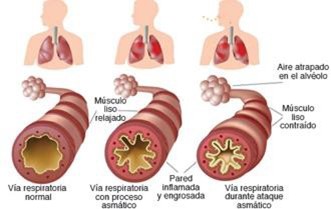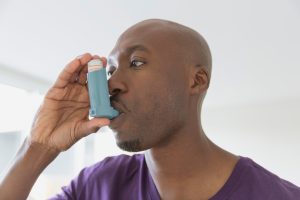
What is Asthma
What is Asthma?
Asthma is a chronic disease that causes the airways to become inflamed and narrow, preventing the passage of air and increasing mucus.
Asthma involves three processes: airway inflammation, smooth muscle contraction, and excess mucus.
 Image from: Link to article
Image from: Link to article
In the first airway in the image you can see what a normal airway looks like. Air can flow in and out without a problem as they have an open space to do so.
The second shows an airway from a person with asthma. The wall inside the pathway begins to swell and thicken, the muscle surrounding the pathway begins to contract, and excess mucus begins to be produced.
During an asthma attack, as seen in the third, increased inflammation occurs, the muscle contracts, and a large amount of mucus is produced. The air cannot flow well, therefore breathing is difficult.
What types of asthma are there?
Most people are diagnosed with one of two types of asthma. The diagnosis is based on medical history of what causes symptom, the severity of symptoms, and disease control.
- Intermittent asthma: This is diagnosed when asthma symptoms arise and then go away. People with intermittent asthma may breathe normally between onset of
- Persistent asthma: This is diagnosed when symptoms tend to occur much of the time. They can be mild, moderate or severe.
Asthma can be diagnosed based on the age that symptoms first appear or what triggers symptoms.
- Childhood asthma: Some children may be diagnosed with asthma as infants or babies. Many others are diagnosed before 5 years of age as their lungs continue to
- Adult-onset asthma: People may develop asthma as adults (after the age of 18). The diagnosis could be the result of several factors, including age, exposure to irritants or development of new allergies.
- Allergic asthma: This is diagnosed when allergens cause symptoms. Common allergens include grass, tree and ragweed pollen, molds, pet dander, dust mites and pests such as cockroaches and Allergic diseases and asthma often go hand-in- hand.
- Nonallergic asthma: This is diagnosed when triggers do not involve allergens. Triggers could involve physical activity, exposure to air pollution, the flu or a cold virus, sudden changes in weather, or stress.
- Exercise-induced asthma: This is a type of asthma triggered by It can affect people of any age. It’s also called exercise-induced bronchospasm.
- Occupational asthma: This is a type of asthma that occurs in the It is diagnosed in people – primarily adults – who experience symptoms as a result of harmful irritants in their workplace environment.
- Asthma-COPD Overlap (ACO): People who are diagnosed with both asthma and chronic obstructive pulmonary disease (COPD) have People whose lungs are damaged by poorly controlled asthma and exposure to irritants such as tobacco smoke are at increased risk of developing COPD.
Information from: Allergy & Asthma Network website, https://allergyasthmanetwork.org/what-is-asthma/
You may also like

Top 9 Food Allergens

What are the most common allergies

